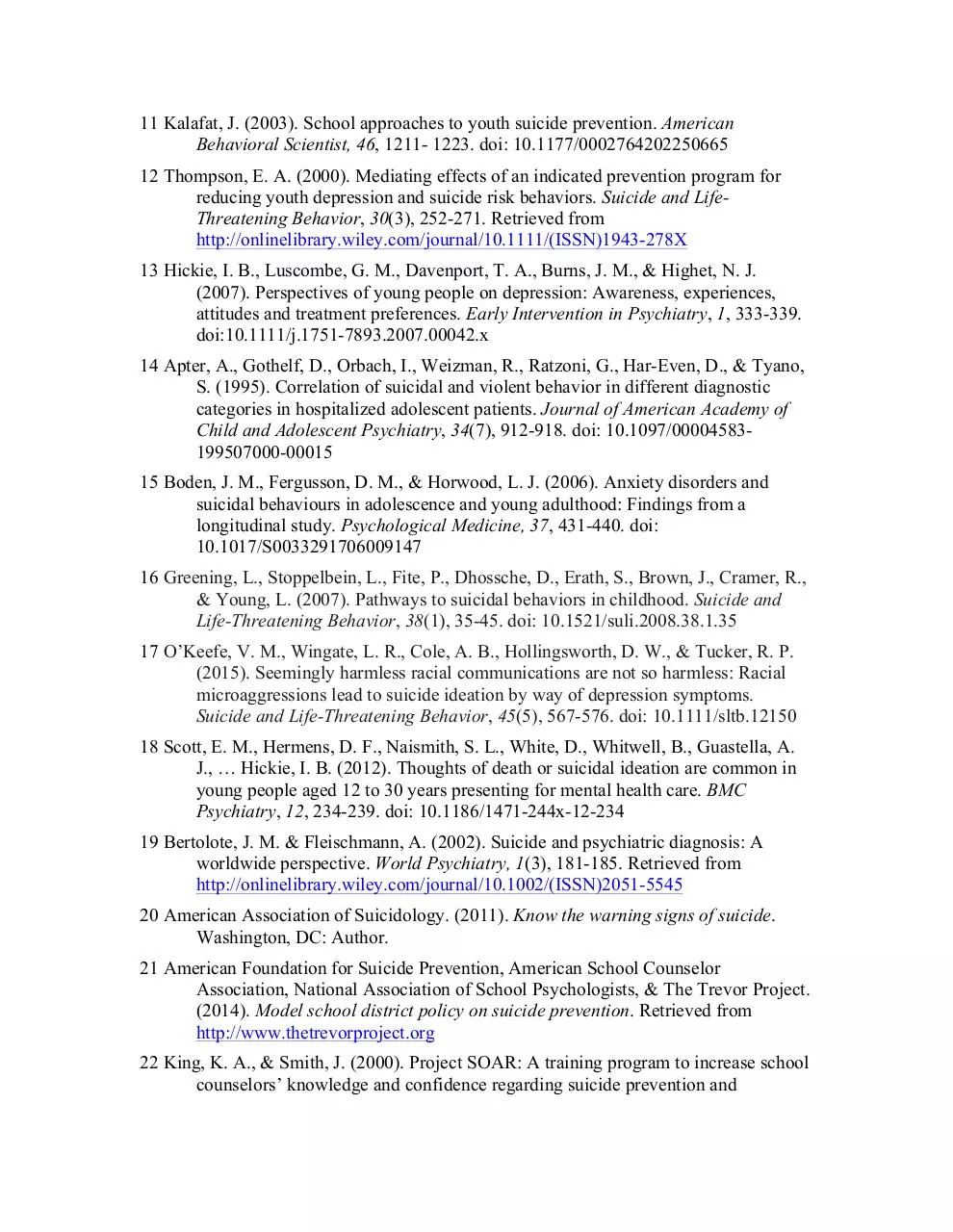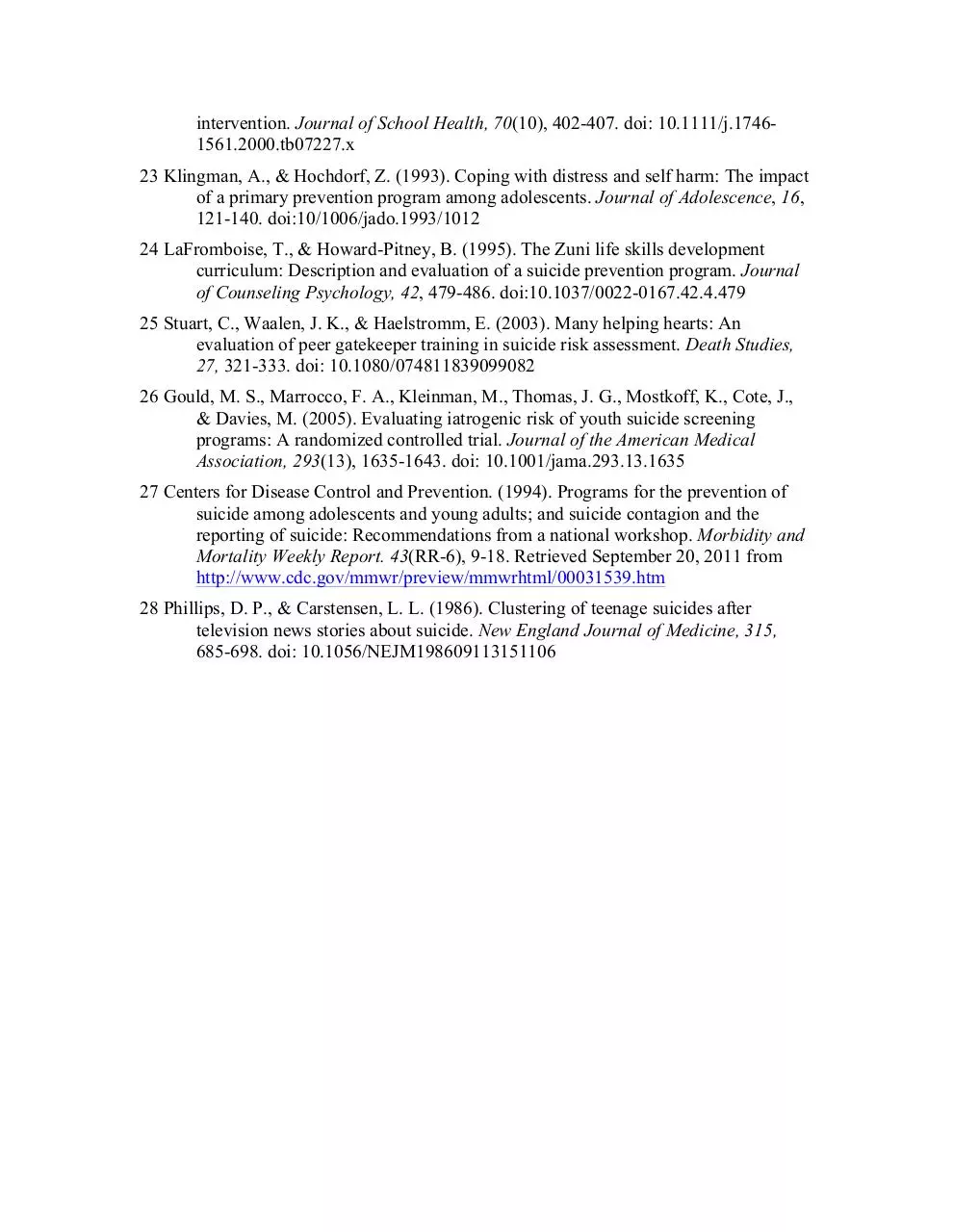Moving Forward References (PDF)
File information
Title: Microsoft Word - Moving Forward - References.docx
This PDF 1.3 document has been generated by Word / Mac OS X 10.9.5 Quartz PDFContext, and has been sent on pdf-archive.com on 05/02/2016 at 20:30, from IP address 153.91.x.x.
The current document download page has been viewed 5452 times.
File size: 98.31 KB (3 pages).
Privacy: public file



File preview
Moving Forward: Examining Comprehensive Youth Suicide
Prevention, Intervention, and Postvention
Katie A. Jacobs, Celeste P. Anderson, Jamie R. Allen, Brooke K. Blythe, & Miranda K. Maher
References
1Centers for Disease Control and Prevention. (2011). 10 leading causes of death by age
group, United States- 2010. Retrieved from
http://www.cdc.gov/injury/wisqars/pdf/10LCID_All_Deaths_By_Age_Group_20
10-a.pdf
2 Centers for Disease Control and Prevention. (2012). 10 leading causes of death by age
group, United States- 2011. Retrieved from
http://www.cdc.gov/injury/wisqars/pdf/leading_causes_of_death_by_age_group_
2011-a.pdf
3 Centers for Disease Control and Prevention. (2013). 10 leading causes of death by age
group, United States- 2012. Retrieved from
http://www.cdc.gov/injury/wisqars/pdf/leading_causes_of_death_by_age_group_
2012-a.pdf
4 Centers for Disease Control and Prevention. (2014). 10 leading causes of death by age
group, United States- 2013. Retrieved from
http://www.cdc.gov/injury/wisqars/pdf/leading_causes_of_death_by_age_group_
2013-a.pdf
5 Eckert, T. L., Miller, D. N., DuPaul, G. J., & Riley-Tillman, T. C. (2003). Adolescent
suicide prevention: School psychologists’ acceptability of school-based programs.
School Psychology Review, 32, 57-76.
6 Whitney, S. D., Renner, L. D., Pate, C. M., & Jacobs, K. A. (2011). Principals’
perceptions of benefits and barriers to school-based suicide prevention programs.
Children and Youth Services Review, 33, 869-877.
doi:10.1016/j.childyouth.2010.12.015
7 Berman, A. L. (2009). School-based suicide prevention: Research advances and
practice implications. School Psychology Review, 38, 233-238.
8 Zenere, F. J., & Lazarus, P. J. (2009). The sustained reduction of youth suicidal
behavior in an urban, multicultural school district. School Psychology Review,
38(2), 189-199.
9 Wyman, P. A., Brown, C. H., Inman, J., Cross, W., Schmeelk-Cone, K., Guo, J, &
Pena, J. (2008). Randomized trial of a gatekeeper program for suicide prevention:
1-year impact on secondary school staff. Journal of Consulting and Clinical
Psychology, 76(1), 104-115. doi 10.1037/0022-006X76.1.104
10 Brock, S. E., Sandoval, J., & Hart, S. (2006). Suicidal ideation and behaviors. In G.
Bear & K. Minke (Eds.), Children’s Needs III: Development, Prevention, and
Intervention (pp. 225-238). Bethesda, MD: National Association of School
Psychologists.
11 Kalafat, J. (2003). School approaches to youth suicide prevention. American
Behavioral Scientist, 46, 1211- 1223. doi: 10.1177/0002764202250665
12 Thompson, E. A. (2000). Mediating effects of an indicated prevention program for
reducing youth depression and suicide risk behaviors. Suicide and LifeThreatening Behavior, 30(3), 252-271. Retrieved from
http://onlinelibrary.wiley.com/journal/10.1111/(ISSN)1943-278X
13 Hickie, I. B., Luscombe, G. M., Davenport, T. A., Burns, J. M., & Highet, N. J.
(2007). Perspectives of young people on depression: Awareness, experiences,
attitudes and treatment preferences. Early Intervention in Psychiatry, 1, 333-339.
doi:10.1111/j.1751-7893.2007.00042.x
14 Apter, A., Gothelf, D., Orbach, I., Weizman, R., Ratzoni, G., Har-Even, D., & Tyano,
S. (1995). Correlation of suicidal and violent behavior in different diagnostic
categories in hospitalized adolescent patients. Journal of American Academy of
Child and Adolescent Psychiatry, 34(7), 912-918. doi: 10.1097/00004583199507000-00015
15 Boden, J. M., Fergusson, D. M., & Horwood, L. J. (2006). Anxiety disorders and
suicidal behaviours in adolescence and young adulthood: Findings from a
longitudinal study. Psychological Medicine, 37, 431-440. doi:
10.1017/S0033291706009147
16 Greening, L., Stoppelbein, L., Fite, P., Dhossche, D., Erath, S., Brown, J., Cramer, R.,
& Young, L. (2007). Pathways to suicidal behaviors in childhood. Suicide and
Life-Threatening Behavior, 38(1), 35-45. doi: 10.1521/suli.2008.38.1.35
17 O’Keefe, V. M., Wingate, L. R., Cole, A. B., Hollingsworth, D. W., & Tucker, R. P.
(2015). Seemingly harmless racial communications are not so harmless: Racial
microaggressions lead to suicide ideation by way of depression symptoms.
Suicide and Life-Threatening Behavior, 45(5), 567-576. doi: 10.1111/sltb.12150
18 Scott, E. M., Hermens, D. F., Naismith, S. L., White, D., Whitwell, B., Guastella, A.
J., … Hickie, I. B. (2012). Thoughts of death or suicidal ideation are common in
young people aged 12 to 30 years presenting for mental health care. BMC
Psychiatry, 12, 234-239. doi: 10.1186/1471-244x-12-234
19 Bertolote, J. M. & Fleischmann, A. (2002). Suicide and psychiatric diagnosis: A
worldwide perspective. World Psychiatry, 1(3), 181-185. Retrieved from
http://onlinelibrary.wiley.com/journal/10.1002/(ISSN)2051-5545
20 American Association of Suicidology. (2011). Know the warning signs of suicide.
Washington, DC: Author.
21 American Foundation for Suicide Prevention, American School Counselor
Association, National Association of School Psychologists, & The Trevor Project.
(2014). Model school district policy on suicide prevention. Retrieved from
http://www.thetrevorproject.org
22 King, K. A., & Smith, J. (2000). Project SOAR: A training program to increase school
counselors’ knowledge and confidence regarding suicide prevention and
intervention. Journal of School Health, 70(10), 402-407. doi: 10.1111/j.17461561.2000.tb07227.x
23 Klingman, A., & Hochdorf, Z. (1993). Coping with distress and self harm: The impact
of a primary prevention program among adolescents. Journal of Adolescence, 16,
121-140. doi:10/1006/jado.1993/1012
24 LaFromboise, T., & Howard-Pitney, B. (1995). The Zuni life skills development
curriculum: Description and evaluation of a suicide prevention program. Journal
of Counseling Psychology, 42, 479-486. doi:10.1037/0022-0167.42.4.479
25 Stuart, C., Waalen, J. K., & Haelstromm, E. (2003). Many helping hearts: An
evaluation of peer gatekeeper training in suicide risk assessment. Death Studies,
27, 321-333. doi: 10.1080/074811839099082
26 Gould, M. S., Marrocco, F. A., Kleinman, M., Thomas, J. G., Mostkoff, K., Cote, J.,
& Davies, M. (2005). Evaluating iatrogenic risk of youth suicide screening
programs: A randomized controlled trial. Journal of the American Medical
Association, 293(13), 1635-1643. doi: 10.1001/jama.293.13.1635
27 Centers for Disease Control and Prevention. (1994). Programs for the prevention of
suicide among adolescents and young adults; and suicide contagion and the
reporting of suicide: Recommendations from a national workshop. Morbidity and
Mortality Weekly Report. 43(RR-6), 9-18. Retrieved September 20, 2011 from
http://www.cdc.gov/mmwr/preview/mmwrhtml/00031539.htm
28 Phillips, D. P., & Carstensen, L. L. (1986). Clustering of teenage suicides after
television news stories about suicide. New England Journal of Medicine, 315,
685-698. doi: 10.1056/NEJM198609113151106
Download Moving Forward-References
Moving_Forward-References.pdf (PDF, 98.31 KB)
Download PDF
Share this file on social networks
Link to this page
Permanent link
Use the permanent link to the download page to share your document on Facebook, Twitter, LinkedIn, or directly with a contact by e-Mail, Messenger, Whatsapp, Line..
Short link
Use the short link to share your document on Twitter or by text message (SMS)
HTML Code
Copy the following HTML code to share your document on a Website or Blog
QR Code to this page

This file has been shared publicly by a user of PDF Archive.
Document ID: 0000338035.